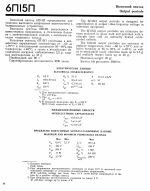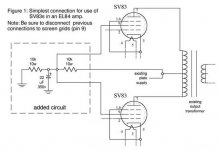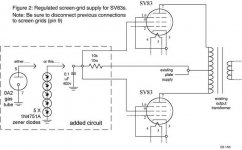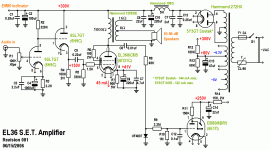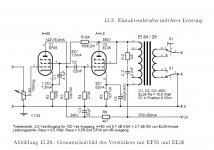Well, it must be 20 years ago or even more, and I've found it on the Svetlana site then which was totally different from what we now see on www.sedtubes.com. Maybe you're right and it was Eric Barbour's contribution. I really don't recall anymore. Sorry!Kay, If you recall where you saw this technical bulletin could you please pass on the link or source? Is it the same or different technical bulletin on this topic by Eric Barbour, issued after they started marketing the 6P15P in the US under the name SV83?
Best regards!
A heater voltage of about 15 V is good for PL84's, but not enough for PL82's. Though being a not that powerful tube, it's heater voltage is about 16.5 V. Anyway, the significant quantity is the heater current of 300mA.The PL82 and PL84 are audio amp valves to start with so just need to get the 15v.
Best regards!
For completeness I wanted to post this specification sheet of a “real“ 6P15P. Note the maxima listed for Ua, Ug2 and Pg2Doug,
Thanks for those measurements. They constitute a valuable data point, and I will make note of it in study. T
Given the screen rating max of 200V claimed for the SV83 your results with the PL83 are noteworthy*. At you operating point I estimate that your PL83 screens are dissipating around 1.1 watt, which is well within the dissipation max of 2 watts for the PL83 (and 1.75 w for SV83). The plates are dissipating ~9.5 watt, a little over specs (9watt) so you may want to keep an eye on that. As noted above, with 12 watts the SV83/6P15P would be loafing under these conditions.
*My theory is that Svetlana arbitrarily gave a screen rating of 200V for the SV83 for marketing purposes and to distinguish it from EL84. As many had stated before, the important specification is the dissipation rating - make sure you are below dissipation limits while you exceed the screen voltage rating.
https://www.diyaudio.com/community/attachments/6p15p-jpg.991055/
Attachments
Here is the post but the linked site is goneBulletinWell, it must be 20 years ago or even more, and I've found it on the Svetlana site then which was totally different from what we now see on www.sedtubes.com. Maybe you're right and it was Eric Barbour's contribution. I really don't recall anymore. Sorry!
Best regards!
Note the guaranteed for 3000 hrs. I bet there are more than a few guitar amps abusing those specs.Note the maxima listed for Ua, Ug2 and Pg2
jeff
Wayback Machine to the rescue...Here is the post but the linked site is goneBulletin
Attachments
Here's another box of free TV tubes from this month's swap meet. I'll have to keep going! A tube caddy full was also picked up. To be shown later, it's late.
Much focus is on the higher powered TV tubes but I like to also look at the rest and think about ways to use them.


To highlight a few of the TV tubes I looked up after hauling them home:
------------------------------------------------
6BU8:
https://frank.pocnet.net/sheets/093/6/6BU8.pdf
Twin Pentode. Separate plates and suppressor grids, with a common screen & control grid and cathode. Innovations and experiments are possible with this interesting feature. The suppressors can be driven from +3 to -50V and so modulate the current to each plate. The G3 curves are fairly linear, as are the grid voltage curves. Worth looking at.
------------------------------------------------
6KE8
https://frank.pocnet.net/sheets/049/6/6KE8.pdf
https://frank.pocnet.net/sheets/201/5/5KE8.pdf
Medium-mu Triode + Sharp-Cutoff Pentode. Intended for 40MHz TV IF oscillator and mixer. The sharp-cutoff Pentode section has a wide range of transconductance as DC grid voltage is varied.
While not specifically meant for it, use as a 'volume leveler' may be possible.
The reason I mention it is because I don't like what the usual free player software does to the sound when the compressor is used as a leveler (apologies to VLC but its compressor is not too convenient).
When I want just a few hours of background music for worktime or chores, I'm not too concerned about a little compression and more concerned about hearing all the tunes at about the same level, regardless of the average level of the 'ripped' file.
On the other hand when I want to hear a specific piece for appreciation, I don't mind manually setting the traditional volume/loudness controls.
Maybe I chase ghosts!
The Triode, intended as an oscillator, also has a variable-mu characteristic, but not as much as the pentode. It ought be a decent voltage amplifier.
------------------------------------------------
12FK6
https://frank.pocnet.net/sheets/106/1/12FK6.pdf
Triode & Double Diode intended to operate from 12.6 Volts on the plate. Heater designed for 10 to 15.9V. Otherwise similar in intended function to the usual 7 pin miniature tube used as detector and audio amp in high voltage receivers.
------------------------------------------------
17JQ6 (same as 6JQ6 ex. fil.)
https://frank.pocnet.net/sheets/191/6/6JH5.pdf (page 5)
Beam power Tube with integral diode. The diode is connected to G3 (beam plates?). Interesting, not sure why the diode is there, but the tube is intended for a 'feedback stabilized vertical deflection amplifier'. High powered plate @ 10W, barely fits into a 9 pin miniature envelope.
------------------------------------------------
40A1
https://frank.pocnet.net/sheets/137/4/40A1.pdf
Ballast tube for use in horizontal deflection amplifier's cathode as a stabilizer (width and HV regulator) in color TV sets. An unusual type but much like the ballast tubes found regulating VT heaters in test gear. Maintains 74-90mA over a range of 20-60V
------------------------------------------------
Much focus is on the higher powered TV tubes but I like to also look at the rest and think about ways to use them.
To highlight a few of the TV tubes I looked up after hauling them home:
------------------------------------------------
6BU8:
https://frank.pocnet.net/sheets/093/6/6BU8.pdf
Twin Pentode. Separate plates and suppressor grids, with a common screen & control grid and cathode. Innovations and experiments are possible with this interesting feature. The suppressors can be driven from +3 to -50V and so modulate the current to each plate. The G3 curves are fairly linear, as are the grid voltage curves. Worth looking at.
------------------------------------------------
6KE8
https://frank.pocnet.net/sheets/049/6/6KE8.pdf
https://frank.pocnet.net/sheets/201/5/5KE8.pdf
Medium-mu Triode + Sharp-Cutoff Pentode. Intended for 40MHz TV IF oscillator and mixer. The sharp-cutoff Pentode section has a wide range of transconductance as DC grid voltage is varied.
While not specifically meant for it, use as a 'volume leveler' may be possible.
The reason I mention it is because I don't like what the usual free player software does to the sound when the compressor is used as a leveler (apologies to VLC but its compressor is not too convenient).
When I want just a few hours of background music for worktime or chores, I'm not too concerned about a little compression and more concerned about hearing all the tunes at about the same level, regardless of the average level of the 'ripped' file.
On the other hand when I want to hear a specific piece for appreciation, I don't mind manually setting the traditional volume/loudness controls.
Maybe I chase ghosts!
The Triode, intended as an oscillator, also has a variable-mu characteristic, but not as much as the pentode. It ought be a decent voltage amplifier.
------------------------------------------------
12FK6
https://frank.pocnet.net/sheets/106/1/12FK6.pdf
Triode & Double Diode intended to operate from 12.6 Volts on the plate. Heater designed for 10 to 15.9V. Otherwise similar in intended function to the usual 7 pin miniature tube used as detector and audio amp in high voltage receivers.
------------------------------------------------
17JQ6 (same as 6JQ6 ex. fil.)
https://frank.pocnet.net/sheets/191/6/6JH5.pdf (page 5)
Beam power Tube with integral diode. The diode is connected to G3 (beam plates?). Interesting, not sure why the diode is there, but the tube is intended for a 'feedback stabilized vertical deflection amplifier'. High powered plate @ 10W, barely fits into a 9 pin miniature envelope.
------------------------------------------------
40A1
https://frank.pocnet.net/sheets/137/4/40A1.pdf
Ballast tube for use in horizontal deflection amplifier's cathode as a stabilizer (width and HV regulator) in color TV sets. An unusual type but much like the ballast tubes found regulating VT heaters in test gear. Maintains 74-90mA over a range of 20-60V
------------------------------------------------
And it's a frame grid too.6JC6A would make a good driver tube and you got five of 'em!
There is an interesting article here, with a screen drive solution ...I found these two schematics for the el36 SE on the internet, and I have the tubes for both amps...So which of these two can You recommend?
The 6CM5/EL36 for Single Ended audio applications
@opcom regarding your lists, I have also picked up a couple of bulk loads of tubes in the past and have been looking at ways to exploit them. I classified them all by base, function (using the European tube naming convention, e.g. 'C' (triode), 'CC' (double triode), 'L' (output pentode), etc), so now I can group them into sets as candidates for different applications.
Then we need to create some solutions to use these tubes up! If there were PCBs to support dome of the solutions, then hopefully demand would increase, and these tubes eventually find a purpose. It is a shame the wiki has disappeared from this site because that is the useful sort of cross-reference that could be very useful.
A joke ...
Two guys are sitting in the waiting room of a psychiatrist. One gets talking to the other,
"So ... what are you doing here then?"
"Well, actually, hmm, well I like sausages!"
The first guy replies, "Sausages? Everyone likes sausages! I like sausages! Nothing wrong with that"
"Really? How many sausages have you got in your collection?"
Then we need to create some solutions to use these tubes up! If there were PCBs to support dome of the solutions, then hopefully demand would increase, and these tubes eventually find a purpose. It is a shame the wiki has disappeared from this site because that is the useful sort of cross-reference that could be very useful.
A joke ...
Two guys are sitting in the waiting room of a psychiatrist. One gets talking to the other,
"So ... what are you doing here then?"
"Well, actually, hmm, well I like sausages!"
The first guy replies, "Sausages? Everyone likes sausages! I like sausages! Nothing wrong with that"
"Really? How many sausages have you got in your collection?"
I see so many possibilities it’s hard to list them, or even make specific recommendations without knowing what your goals might be, or what else you may have in your stash to work with. A lot of possibilities that would end up being snowflakes - maybe not even stereo. What to try to build first would depend on what kind of iron you have access to, or willing to spend money on, for instance. What power or OPTs are on hand? Can you custom wind? How much are you willing to throw at new ones?
The tube caddy had some other interesting types, slightly different mix. I keep in mind that I have no idea how many are good.
View attachment 1133638
View attachment 1133642
On these lists I see you could make a Williamson of sorts using the 6BQ6 or 6DQ6, and the 8CG7/8FQ7 tubes.
The 6CW5/8CW5 are also nice tubes and one of my favorite families of pentodes.
There do seem to be enough of the 6BQ6’s to do something with. The CG7’s seem to be all over the map for heater voltage though. Plenty of CW5’s, but I saw 3 heater voltages. Like you would want a custom power trafo you could select heater taps with - maybe even different for each channel. Lots of interesting stuff that lends themselves to just singles, a couple pairs of big sweeps, but only one quad of 20+ watters (24JE6).
Nah, I'd do DC for the smaller tubes, then you can set it to whatever you want. Easy enough these days. Or get creative with dropper resistors or series connected filaments. 24 volts can do three 8 volt, or four 6 volt in series. Rectify it and use an LM317 regulator with the minimum component count, or run an SMPS for all the heaters. Easy peasy.
Might want the option of sticking in 8CW5’s in one channel and 15’s in the other. Either multiple trafo taps or DC-DC converters with multiple outputs.
I started playing with CW5’s - but I bought all the 10 volt version. Got a couple of projects in mind, but who the hell knows when I‘ll get to them. They lend themselves well to getting decent watts off of 200V supplies, where you can use a single power toroid as an OPT.
I started playing with CW5’s - but I bought all the 10 volt version. Got a couple of projects in mind, but who the hell knows when I‘ll get to them. They lend themselves well to getting decent watts off of 200V supplies, where you can use a single power toroid as an OPT.
- Home
- Amplifiers
- Tubes / Valves
- Those Magnificent Television Tubes
